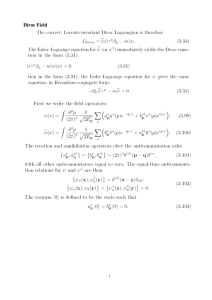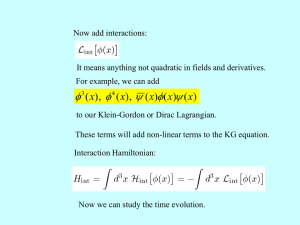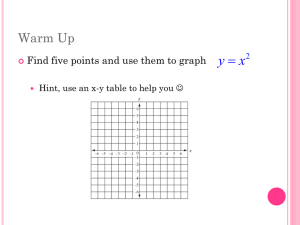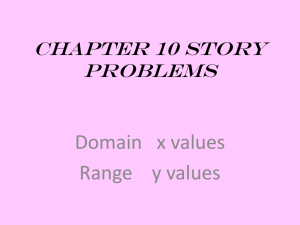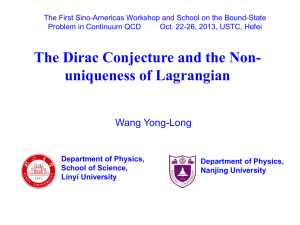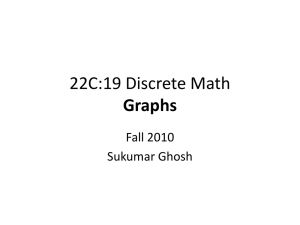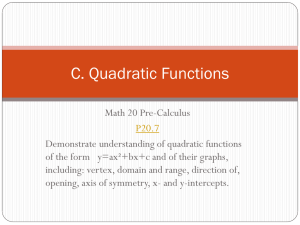PowerPoint
advertisement
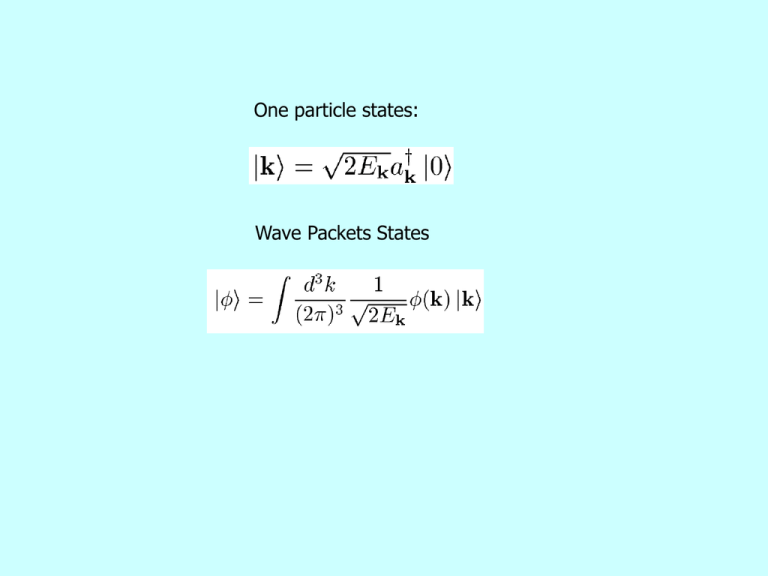
One particle states: Wave Packets States Heisenberg Picture Combine the two eq. KG Equation Dirac field and Lagrangian The Dirac wavefunction is actually a field, though unobservable! Dirac eq. can be derived from the following Lagrangian. L L L i m i m i m 0 i m 0 i m 0 i m 0 Negative energy! Anti-commutator! A creation operator! ~ ~ b b, b b b annihilate an antiparticle! a , a 0 a a p p a p a p 0 a p 0 p Exclusion Principle p p p a a p Now add interactions: For example, we can add 3 ( x), 4 ( x), ( x) ( x) ( x) to our Klein-Gordon or Dirac Lagrangian. Interaction Hamiltonian: Schrodinger Picture Heisenberg Picture We can move the time evolution t the operators: Heisenberg Equation Interaction picture H H 0 H int States and Operators both evolve with time in interaction picture: S OI (t ) eiH0t / OS eiH0t / Evolution of Operators OI (t ) eiH0t / OS eiH0t / I (t ) eiH t / S eiH t / 0 d i H 0 , dt 0 dOI i H 0 , OI dt Operators evolve just like operators in the Heisenberg picture but with the full Hamiltonian replaced by the free Hamiltonian Field operators are free, as if there is no interaction! Evolution of States S States evolve like in the Schrodinger picture but with Hamiltonian replaced by V(t). V(t) is just the interaction Hamiltonian HI in interaction picture! That means, the field operators in V(t) are free. Interaction Picture Operators evolve just like in the Heisenberg picture but with the full Hamiltonian replaced by the free Hamiltonian d i H 0 , dt States evolve like in the Schrodinger picture but with the full Hamiltonian replaced by the interaction Hamiltonian. d i I (t ) H I I (t ) dt U operator d i I (t ) H I I (t ) dt Define time evolution operator U I (t ) U (t, t0 ) I (t0 ) All the problems can be answered if we are able to calculate this operator. It’s determined by the evolution of states. d d i I (t ) U (t , t 0 ) I (t 0 ) H I U (t , t 0 ) I (t 0 ) dt dt d i U (t , t 0 ) H I U (t , t 0 ) dt Perturbation expansion d i U (t , t 0 ) H I U (t , t 0 ) dt Solve it by a perturbation expansion in small parameters in HI. U (t, t0 ) U (0) (t, t0 ) U (1) (t, t0 ) To leading order: d (1) i i U (t , t 0 ) H I U ( 0) (t , t 0 ) H I dt i U (1) (t , t 0 ) dt ' H I (t ' ' ) t0 t U (0) (t , t0 ) 1 Define S matrix: 3 S i dt H (t ) i dt dx HI ( x, t ) i d 4 x LI ( x) It is Lorentz invariant if the interaction Lagrangian is invariant. Vertex In ABC model, every particle corresponds to a field: A A ( x) A( x) Add an interaction term in the Lagrangian: The transition amplitude for the decay of A: can be computed: To leading order: BC U I , A BC S A a a Numerical factors remain B C ig A Momentum Conservation A aa interaction Lagrangian a a B C a a vertex Every field operator in the interaction corresponds to one leg in the vertex. Every field is a linear combination of a and a+ a a Every leg of a vertex can either annihilate or create a particle! This diagram is actually the combination of 8 diagrams! A B C interaction Lagrangian vertex There is a spacetime integration. Interaction could happen anytime anywhere and their amplitudes are superposed. The integration yields a momentum conservation. This is in momentum space. L I 4 a a interaction Lagrangian vertex Every field operator in the interaction corresponds to one leg in the vertex. Every leg of a vertex can either annihilate or create a particle! a a L I g a b b a interaction Lagrangian vertex Every field operator in the interaction corresponds to one leg in the vertex. Every leg of a vertex can either annihilate or create a particle? a a L I g a b b a interaction Lagrangian vertex Every leg of a vertex can either annihilate or create a particle? a b can either annihilate a particle or create an antiparticle! b a can either annihilate an antiparticle or create a particle! The charge flow is consistent! So we can add an arrow for the charge flow. L I g a b b a External line When Dirac operators annihilate states, they leave behind a u or v ! ( x) a u eipx b v eipx e ( p1 ) p 3 a p ' p 2 p 2 p p' 0 Feynman Rules for an incoming particle ( x) b v eipx a u eipx p u p1 0 e ( p1 ) v p1 0 Feynman Rules for an incoming antiparticle A ( x) a a LI gA g b a u p2 a b u p1 Propagator A A B B i d U (t , t 0 ) H I U (t , t 0 ) dt t dU ( 2 ) (t , t 0 ) (1) i H I (t ) U (t , t 0 ) H I (t ) dt ' H I (t ' ) dt t0 t '' (t , t 0 ) dt' ' H I (t ' ' ) dt' H I (t ' ) t0 t0 t U ( 2) The integration of two identical interaction Hamiltonian HI. The first HI is always later than the second HI t U ( 2) t 1 (t , t 0 ) dt ' ' dt ' T H I (t ' ' ) H I (t ' ) 2 t0 t0 T ( A(t1 ) B(t 2 )) (t1 t 2 ) A(t1 ) B(t 2 ) (t 2 t1 ) B(t 2 ) A(t1 ) This definition is Lorentz invariant! S ( 2 ) U ( 2 ) (, ) 1 d 4 x1 d 4 x2 T L I ( x1 ) L I ( x2 ) 2 Amplitude for scattering A A B B B( p3 )B( p4 ) S A( p1 ) A( p2 ) B( p3 ) B( p4 ) d 4 x1 d 4 x2 T g A( x1 ) B( x1 ) C ( x1 ) gA( x2 ) B( x2 ) C ( x2 ) A( p1 ) A( p2 ) d 4 x1 d 4 x2 e i ( p1 p3 ) x2 e i ( p2 p4 ) x1 0 T C ( x1 ) C ( x2 ) 0 Fourier Transformation p1-p3 pour into x2 p2-p4 pour into x1 Propagator between x1 and x2 t1 t2 0 T C( x1 ) C( x2 ) 0 0 C( x1 ) C( x2 ) 0 0 a a a a x1 A particle is created at x2 and later annihilated at x1. B(p4) B(p3) B(p3) B(p4) x1 x2 A(p1) C(p1-p3) C A(p2) A(p1) A(p2) x2 0 t1 t2 0 T C( x1 ) C( x2 ) 0 0 C( x2 ) C( x1 ) 0 0 a a a a x2 A particle is created at x1 and later annihilated at x2. B(p4) B(p3) B(p4) B(p3) x2 B(p4) x1 C A(p1) B(p3) x1 A(p2) x2 A(p1) C(p1-p3) C A(p2) A(p1) A(p2) x1 0 ipx1 iqx2 4 4 d x d x e 1 2 e 0 T C ( x1 ) C ( x2 ) 0 B(p4) B(p3) B(p4) B(p3) x2 B(p3) B(p4) x1 C A(p1) i 4 ( p q) 2 2 q mC x1 A(p2) x2 A(p1) C(p1-p3) C A(p2) A(p1) A(p2) 0 T ( x) ( y) 0 0 T ( x) ( y) 0 0 T ( x) ( y) 0 0 T ( x) ( y) 0 This doesn’t look explicitly Lorentz invariant. But it is! 0 T ( x) ( y) 0 x0 y0 a a a a Every field either couple with another field to form a propagator or annihilate (create) external particles! Otherwise it will vanish! Scalar Antiparticle Antiparticles can be introduced easily by assuming that the field operator is a complex number field. L0 m2 d3p ( x) (2 ) 3 1 2 a e p ipx b p e ipx Complex KG field can either annihilate a particle or create an antiparticle! d3p 1 ipx ipx ( x) b e a p pe (2 ) 3 2 Its conjugate either annihilate an antiparticle or create a particle! The charge flow is consistent! So we can add an arrow for the charge flow. L I g 3 g 3 vertex Charge non-conserving LI 2 vertex Charge conserving Propagator: 0 T ( x1 ) ( x2 ) 0 t1 t2 0 T ( x1 ) ( x2 ) 0 0 ( x1 ) ( x2 ) 0 0 b a a b An antiparticle is created at x2 and later annihilated at x1. B(p4) B(p3) B(p3) B(p4) x1 x2 A(p1) C(p1-p3) C A(p2) A(p1) A(p2) x1 x2 0 t1 t2 0 T ( x1 ) ( x2 ) 0 0 ( x2 ) ( x1 ) 0 0 a b b a x2 A particle is created at x1 and later annihilated at x2. B(p4) B(p3) B(p4) B(p3) x2 B(p4) x1 C A(p1) B(p3) x1 A(p2) x2 A(p1) C(p1-p3) C A(p2) A(p1) A(p2) x1 0 ipx1 iqx2 4 4 d x d x e e 0 T ( x1 ) ( x2 ) 0 1 2 B(p4) B(p3) B(p4) B(p3) x2 B(p3) B(p4) x1 C A(p1) i 4 ( p q) 2 2 q mC x1 A(p2) x2 A(p1) C(p1-p3) C A(p2) A(p1) A(p2) LI B B(p4) B(p3) B(p4) B(p3) x2 x1 C A(p1) x1 A(p2) x2 A(p1) B(p3) B(p4) B C(p1-p3) B C A(p2) A(p1) A(p2) U(1) Abelian Symmetry L0 m2 The Lagrangian is invariant under the phase transformation of the field operator: ( x) e iQ ( x) eiQ eiQ (x) LI 2 invariant If A,B,C become complex, they carry charges! A C The interaction is invariant only if QA QB QC 0 U(1) symmetry is related to charge conservation! B L i m The Dirac Fermion Lagrangian is also invariant under U(1) ( x) eiQ ( x) L eiQ eiQ i m L SU(N) Non-Abelian Symmetry Assume there are N kinds of fields 1 2 3 n If they are similar, we have a SU(N) symmetry! ( x) U ( x) e L0 m2 i iT i ( x) LI are invariant under SU(N)! 2 量子力學下互換群卻變得更大! 量子力學容許量子態的疊加 u u a u d c u + b d d 古典 + d d 量子 a b 1 2 u-d 互換對稱 2 c d 1 2 2 ac* bd * 0 u u a b U , U d d c d * a b a * UU c d b c* 1 * d ( x) U ( x ) ( x) U ( x) L0 m 2 U U m 2 U U m2 L I U U 2 They are invariant under SU(N)! 2 2 Gauge symmetry ( x) eiQ ( x) ( x) Global Symmetry ( x) e iQ ( x) eiQ eiQ (x) e iQ ( x) e iQ ( x) eiQ e iQ (x) Gauge (Local) symmetry ( x) eiQ ( x) ( x) eiQ ( x) eiQ ( x) ( x) e iQ ( x ) ( x) e iQ ( x ) ( x) iQ ( ) e iQ ( x ) ( x) Kinetic energy is not invariant under gauge transformation! Could we find a new “derivative” that works as if the transformation is global? D ( x) eiQ ( x) D ( x) eiQ (x) e iQ ( x ) ( x) e iQ ( x ) ( x) iQ ( ) e iQ ( x ) ( x) To get rid of the extra term, we introduce a new vector field: A ( x) A ( x) ( x) D iQ A D iQA e iQ ( x) D ( x) iQ ( ) e iQ ( x) ( x) iQ ( ) e iQ ( x) ( x) e iQ ( x) D ( x) Global Symmetry Gauge (Local) symmetry ( x) eiQ ( x) ( x) ( x) e iQ ( x) D ( x) eiQ ( x) D ( x) eiQ (x) D D eiQ e iQ (x) D eiQ e iQ D ( x) D D Replacing derivative with D D is invariant under gauge covariant derivative, transformation! D D iQ A iQ A Q2 A A The scalar photon interaction vertices L i m To force it to be gauge invariant, ( x) eiQ ( x) ( x) you only need to replace derivative with coariant derivative. D L i D m is gauge invariant! This gauge invariant Lagrangian gives a definite interaction between fermions and photons i m Q L i D m i Q A m LI gA A g A ( x) a a LI gA g b a u p2 a b u p1 LI gA This form is forced upon us by gauge symmetry! It is really a Fearful Symmetry! Tony Zee Tyger! Tyger! burning bright In the forests of the night What immortal hand or eye Could frame thy fearful symmetry! William Blake Let there be light! In the name of gauge symmetry! Hermann Weyl, 1885-1955 Yang and Mills SU(N) Non-Abelian Symmetry Assume there are N kinds of fields 1 2 3 n If they are similar, we have a SU(N) symmetry! ( x) U ( x) e L0 m2 i iT i ( x) LI are invariant under SU(N)! 2 Non-Abelian Gauge Symmetry ( x) U ( x) ( x) e i ( x) T ( x) i i We need one gauge field for each generator. D igT i Ai Gauge fields transform as: 1 A T U A T U i U U g i i i i i D igT i Ai U ig UT i Ai U 1 U U 1 U g U U ig UT i Ai U U 1U U D D U D D D is invariant under gauge transformation! L i D m i m Q L i D m i Q T i Ai m LI gAi T i T i Ai g T i e e W ? e e 3 W i 1 g e 0 1 i 2 × 2 matrices e Wi i e i e 0 i 1 0 3 0 0 1 2 1 1 0 i i W W iW W3 W i Wi i W 3iW 1 W 2 2 W 2 3 1 W1 iW2 2 ,W 2 W W3 W1 iW2 2 1 2 L m 2 V m 2 2 2 V m 2 2 Vacua happen at: m2 v2 Choose: 0 v For infinitesimal transformation: 0 U 0 0 iT i 0 T 0 0, (T 3 Y )0 0, (T 3 Y )0 0 SU(2)χU(1)Y is broken into U(1)EM gT D D D 0 D 0 gT W gT 3W3 g ' YB 0 T W g 2 T 0 0 3 3 0 g' B gW 3 g' B Z become massive W become massive Z Photon is massless. A W gT 3W 3 g ' YB 0 T gW T 3 0 W 1 g 'W 3 gB 2 2 g g' 1 gW 3 g ' B 2 2 g g'


